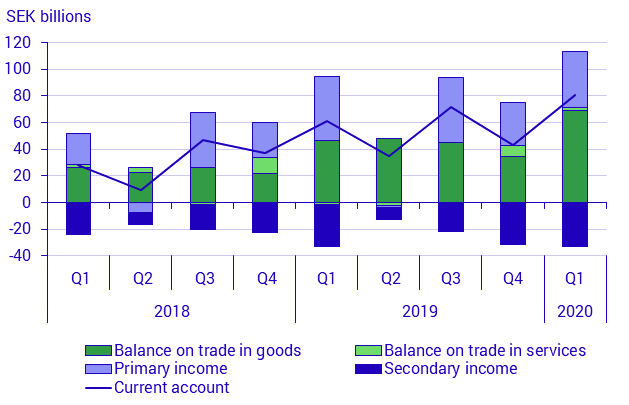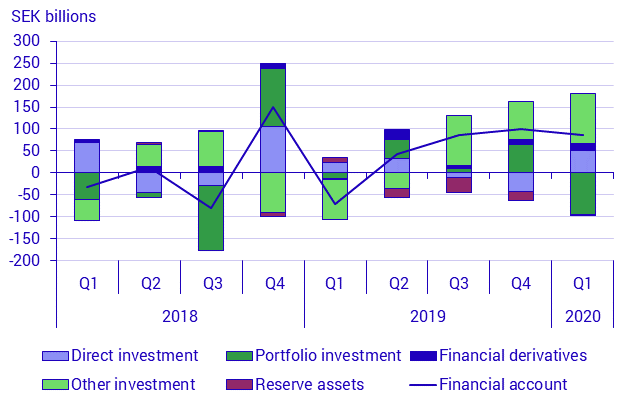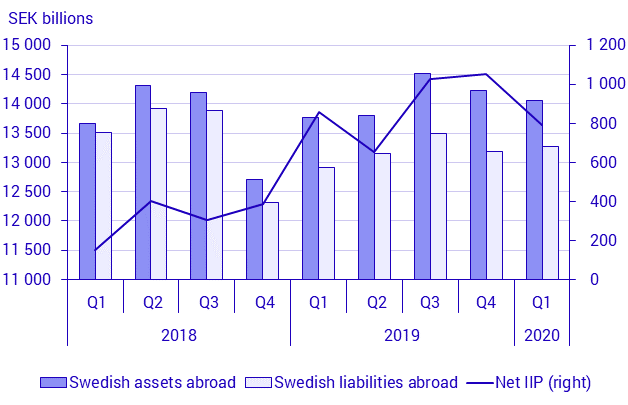Balance of payments, 1st quarter 2020
More goods exports and less goods imports strengthened Sweden’s current account
Statistical news from Statistics Sweden 2020-06-08 9.30
The current account surplus widened to SEK 80.6 billion in the first quarter of 2020, SEK 19.2 billion more than in the first quarter of 2019. Balance on trade in goods was the main contributing factor to the higher surplus.
The financial account shows that net lending with the rest of the world amounted to SEK 85.2 billion in the first quarter. Sweden’s net external assets position, presented in the international investment position, amounted to SEK 789.1 billion at the end of the first quarter of 2020.
What is the Balance of Payments?
The balance of payments is a statement of all Swedish transactions with the rest of the world. It presents exports and imports of goods and services, and includes a description of changes in financial assets and liabilities with the rest of the world. The balance of payments consists of the current account, the financial account, and the capital account. The component parts of the Balance of Payments and related terms are explained under Definitions and explanations, at the end of this item of statistical news.
Current account surplus as share of Sweden’s GDP increased
Sweden’s current account as a percentage of GDP has widened in recent quarters, and amounted to 4.6 percent in the first quarter of 2020, calculated as a moving average over the last four quarters. The current account as a percentage of GDP last reached this level in the first half of 2014.

Comparisons between periods in the current account are made using the corresponding quarter the previous year.
Balance on trade in goods presented a widened surplus
The balance on trade in goods resulted in a surplus of SEK 68.8 billion, widened by SEK 22.1 billion from the first quarter of 2019. Goods exports amounted to SEK 426.5 billion, up by SEK 13.0 billion compared with the corresponding quarter a year ago. Goods imports amounted to SEK 357.7 billion, down by SEK 9.1 billion in a corresponding comparison. Surplus in merchanting, which is included in the balance on trade in goods, amounted to SEK 30.2 billion, up by SEK 0.5 billion from the first quarter of 2019.
Balance on trade in services went from deficit to surplus
The balance on trade in services noted a surplus of SEK 2.4 billion, compared with the deficit of SEK 1.2 billion in the first quarter of 2019. Export of services amounted to SEK 171.9 billion, up by SEK 5.4 billion compared with the corresponding quarter a year ago. At the same time, import of services amounted to SEK 169.5 billion, up by SEK 1.9 billion in a corresponding comparison.
Primary income surplus narrowed
Primary income, which consists mainly of compensation of employees and investment income, presented a surplus of SEK 42.2 billion in the first quarter. This surplus narrowed by SEK 5.3 billion compared with the corresponding quarter a year ago. The primary income narrowed as surplus in investment income decreased, partly offset by increased surpluses in compensation of employees and other primary income. The surplus in investment income went from SEK 43.8 billion in the first quarter of 2019 to SEK 37.1 billion in the first quarter of 2020.
Portfolio investment contributed a surplus of SEK 19.0 billion to investment income, down by SEK 3.4 billion compared with the corresponding quarter a year ago. Investment income on direct investment contributed a surplus of SEK 18.0 billion, down by SEK 2.4 billion in the same comparison.
Secondary income deficit widened
Secondary income, which includes current international cooperation and contributions to the EU, presented a deficit of SEK 32.7 billion. This deficit increased by SEK 1.0 billion compared with the corresponding quarter a year ago.
Net lending in the financial account
The financial account noted net lending amounting to SEK 85.2 billion in the first quarter of 2020. Net lending and net borrowing refer to the overall balance on the financial account.
Other investment, direct investment and financial derivatives in the financial account present net lending during the quarter. At the same time, portfolio investment present net borrowing and reserve assets present decreased net lending during the quarter.

Swedish direct investment abroad increased
Net lending in direct investment amounted to SEK 51.6 billion during the quarter. Swedish direct investment abroad increased by SEK 100.6 billion, while foreign direct investment in Sweden increased by SEK 49.0 billion.
Swedish portfolio investment abroad decreased
Net borrowing in portfolio investment amounted to SEK 95.3 billion during the quarter. Swedish investors decreased their portfolio investment abroad by SEK 141.1 billion, while foreign investors decreased their portfolio investment in Sweden by SEK 45.8 billion.
Other investment increased abroad and in Sweden
Net lending in other investment corresponded to SEK 114.2 billion. Swedish other investment abroad increased by SEK 384.9 billion, while foreign other investment in Sweden increased by SEK 270.8 billion.
Financial derivatives and reserve assets
Net lending in financial derivatives amounted to SEK 15.8 billion. Reserve assets noted decreased net lending corresponding to SEK 1.1 billion.
Net assets in Sweden’s international investment position decreased
Sweden’s net external assets position amounted to SEK 789.1 billion, which means a narrowing compared with the previous quarter, when net assets amounted to SEK 1053.3 billion. Portfolio investment contributed most to the decrease of net assets, through increased net liabilities.

Comparisons between periods in the international investment position are made using the previous quarter.
Swedish external liabilities increased
Swedish external liabilities amounted to SEK 13 275.3 billion, SEK 94.1 billion more than in the last quarter. This change is largely due to an increase in Sweden’s external liabilities in other investment. The external liabilities in financial derivatives also showed an increase, while the decrease in external liabilities in portfolio investment counteracted.
Swedish external assets decreased
Swedish external assets amounted to SEK 14 064.3 billion, SEK 170.3 billion less than in the last quarter. Portfolio investment was the main contributor to the decrease, offset mainly by other investment.
Sweden’s largest net external assets are in direct investment
Direct investment, other investment and reserve assets account for the largest net external assets. The largest net liabilities are in long-term debt securities in portfolio investment.
Differences between the Balance of Payments and the National Accounts
There are differences between estimations in the Balance of Payments and the National Accounts. There has been a focus on coordinating sources and methods in the calculation of the current account in order to increase the agreement between the statistics.
The results of this work were implemented in connection with the publication of the first quarter of 2020 for both the Balance of Payments and the National Accounts calculations of GDP in the real sector accounts. This has led to revisions of the time series.
The coordination of the Balance of Payments and National Accounts means that estimates of primary statistics, such as foreign trade in services, may differ from values published in the respective surveys.
Efforts to improve agreement in the current account will continue going forward. Work has also begun on increasing agreement between the financial parts of the Balance of Payments and the financial accounts.
Find more information here: (LÄNK till hela texten I fördjupad information)
Revisions
Due to the coordination between the Balance of Payments and the National Accounts, the revision policy was not followed. The time series for the Balance of Payments and the international investment position have been revised from Quarter 1 2018. Method changes in the coordination have resulted in minor adjustments from 1990 in the time series on export of goods in the current account balance. Further adjustments will be made in the time series.
The Balance of Payments adheres to a predetermined revision policy, see Section 2.3 in the 2020 Quality Declaration.
Kvalitetsdeklarationen 2020 (pdf)
In a compilation of the balance of payments and the international investment position, data based on forecasts is used in some cases. The statistics will be updated as results are received. If new data is added or any methodological changes are made, further revisions are carried out as necessary.
Revisions carried out in connection with the publication of the first quarter 2020 are listed in the tables on revisions by account item in the balance of payments and the international investment position, respectively.
Definitions and explanations
The current account and the financial account record real and financial transactions with regard to the rest of the world. Only transactions are recorded; value changes, such as exchange rate fluctuations are excluded.
The current account shows the trade in goods (foreign trade in goods), the trade in services (foreign trade in services), primary income (compensation to employees, investment income, other primary income), and secondary income (current transfers). Surplus and deficit in the current account refer to the difference between Sweden’s exports and Sweden’s imports. A positive outcome results in a surplus, while a negative outcome results in a deficit. Comparisons between periods in the current account are always made using the corresponding quarter the previous year, due to seasonal patterns in data.
The financial account consists of direct investment, portfolio investment, financial derivatives, other investment, and reserve assets. Sweden can acquire and dispose of financial assets abroad. All transactions during the quarter concerning external assets show Sweden’s change in net external assets. Sweden can also borrow and repay financial external liabilities. All transactions during the quarter concerning external liabilities show Sweden’s change in net external liabilities. The difference between Sweden’s change in net external assets and Sweden’s change in net external liabilities can be positive or negative, and shows net lending and net borrowing, respectively.
The capital account records Sweden’s capital transfers and transfers of non-financial assets with regard to the rest of the world. Compared with other parts of the balance of payments, amounts in the capital account are usually small.
The difference between Sweden’s financial external assets and liabilities position is the net of Sweden’s international investment position, which can be positive or negative.
An increase or decrease in assets describes Sweden’s external assets. An increase or decrease in liabilities describes Sweden’s external liabilities.
Merchanting, which forms a part of the trade in goods, refers to triangular trade in which goods are purchased and sold abroad without the good crossing a Swedish border.
Statistical Database
More information is available in the Statistical Database
Feel free to use the facts from this statistical news but remember to state Source: Statistics Sweden.
